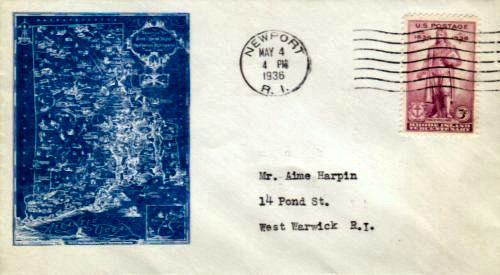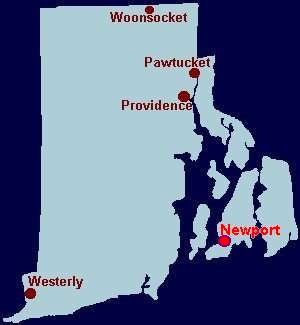![]()
Postal History Introduction
Stampless
Covers
1846
to 1900 Issues
1901-1950
Issues
1951-2003
Issues
Cancels
&
Miscellaneous
Postal
Stationery
Post
Cards
Air
Mail
First
Day &
Event Covers
Parcel Post/Special Delivery
Registered & Official Mail
Commercial & Advertising
Revenue & Postage Due
Wildlife & Game Issues
Complete List of RI Issues
|
Rhode Island Tercentenary Issue
First Day Cover |
|
|
|
|
Unofficial City Cancel -
Newport , RI |
|
|
The Post Office in Newport, (Newport Township, Newport County) Rhode Island was established prior to 1790, however the official establishment was on June 24, 1790. The first postmaster was Jacob Richardson. This post office is currently operating under Postmaster George F. McKiernan appointed on September 30, 2006. The city of Newport - Newport County is in the southeastern part of Rhode Island. It is located on the southern end of Aquidneck (Rhode) Island in Narragansett Bay. The city was founded in 1639 by a group of religious refugees from the Massachusetts Bay Colony led by William Coddington. Originally Coddington was part of a group that settled Portsmouth, RI, however after a falling out, he led his followers to the south and founded Newport. Because of its excellent harbor, Newport soon became one of the most important seaports of colonial North America. The town's early merchants prospered in the "Triangular Trade" of rum, molasses and slaves between New England, Africa and the Caribbean. James Franklin, an older brother of Benjamin established the first Rhode Island printing press in Newport in 1727 and his son James, Jr. established the "Newport Mercury," which is still in print today as a weekly newspaper. The British occupation of Newport from 1776 to 1779 caused most of the city's prominent merchants to flee to Providence and other mainland cities. The "Battle of Rhode Island" was fought in the area around Newport and the "1st Rhode Island Regiment" composed mostly of African American soldiers held the line for over four hours against superior British and Hessian forces. It was due to their valiant efforts during this battle that the American Army was able to escape. General Lafayette called it, "The best fought action of the war." After the Civil War due to its temperate climate and scenic location, Newport became the in place for the summer homes of the American Nobility (extremely rich). The Vanderbilt's, Kennedy's Rockefellers and others built many palatial mansions along the coastline. They are among Newport's major tourist attractions today. Newport was one of the five original Rhode Island capital cities, (each serving in rotation). This was reduced to just Newport and Providence in 1854. Providence became the sole Capital in 1900. Newport contains a great many original colonial buildings including: the Friends Meeting House (1699), the Old Colony House (1739), Trinity Church (1725–26), Touro Synagogue (1763), Redwood Library and Athenaeum (1747), and the Artillery Company of Newport (1741) Military Museum. The old section of Newport, known as The Point - on the harbor front, has homes of colonial merchants, including Hunter House (1748), now restored as a museum. The Old Stone Mill is a circular stone tower that is probably one of the oldest European-built edifices in the United States. (It is believed to have been built as a windmill for an early settler by Narragansett Indian labor.) The International Tennis Hall of Fame and Museum is located in the Newport Casino and the city has long been known as a yachting center. The America Cup Races were held here until 1980 and the Museum of Yachting is located in Fort Adams State Park. The city was the site of the Newport Jazz Festival from 1954 until 1971, when it was moved to New York. A festival of classical music is held annually in Newport in July, and a revived jazz festival is held there in August. Newport was incorporated as a city in 1784 and resumed the town form of government in 1787, but in 1853 it was reincorporated as a city. The United States Navy continues to be a major factor in the city with its complex of commands and installations, including the Naval Education and Training Center, Naval War College, Surface Warfare Officers School Command, Naval Justice School, and Naval Undersea Warfare Center.
Sources: |
![]()
RI Historical
Society
The Post Offices
Home Page
RI Tercentenary Issue History
RI Philatelic Society
Recently Added Pages
Philatelic Primer
Rhode Island Around the World
Rhode Island
Town Postmarks
Other Websites of Interest
Return to
Tercentenary Thumbnail Page 5
OR
Return to
Unofficial Town Cancels Page 4

